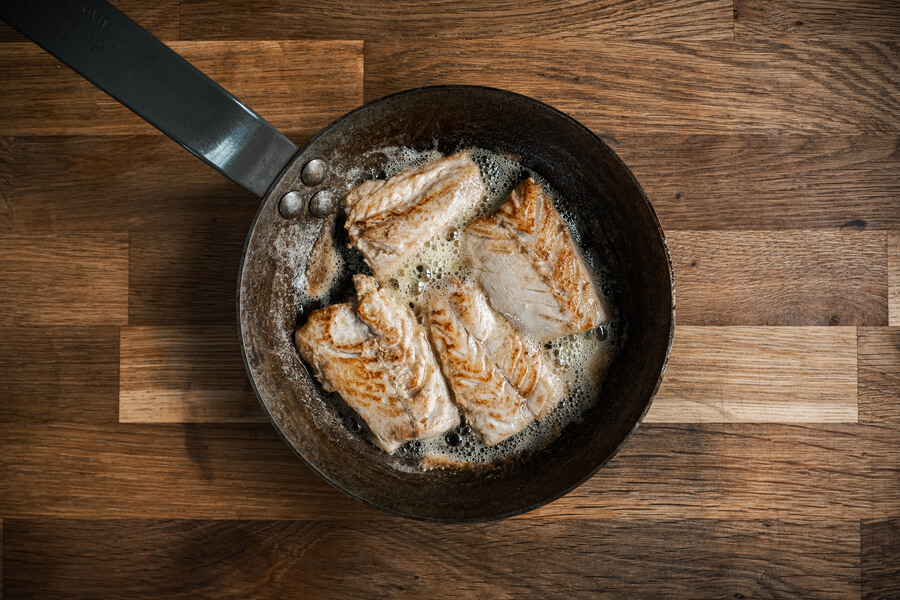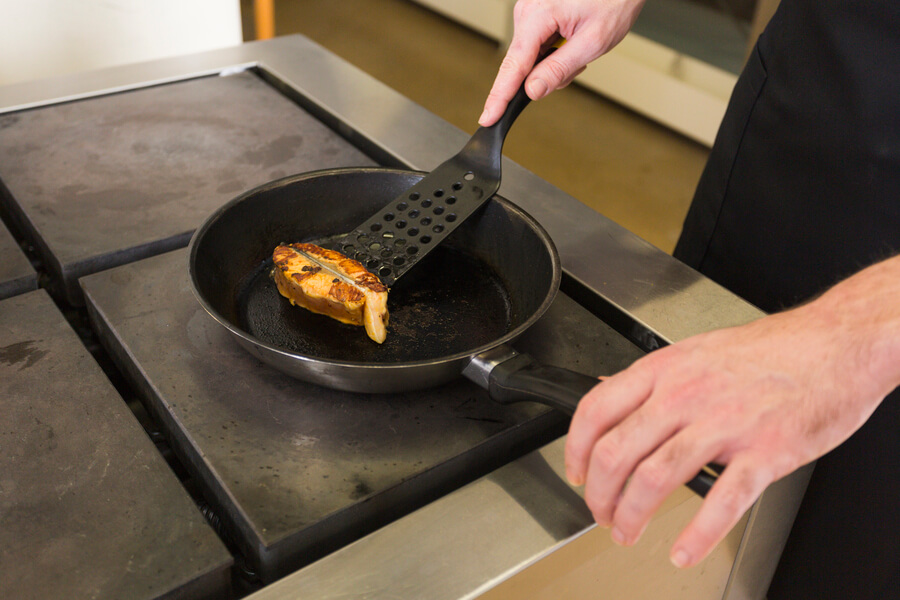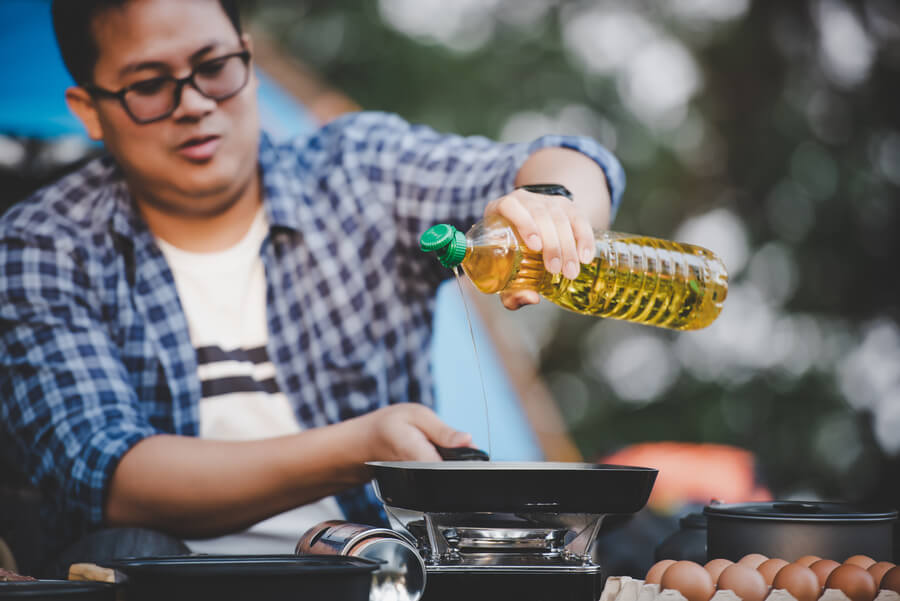After cooking a delicious meal, finding your cast iron in a sticky mess can be disheartening. If you’re using cast iron to cook or bake, there are simple ways to stop food from sticking to it. You must understand why food sticks to your pan and how to stop it.

Why Food is Sticking to Cast Iron and How Do You Solve the Problem?
It’s common for food to stick to cast iron cookware, but it’s usually preventable or manageable. Here are some reasons why food might stick to your cast iron pan and how to make an adjustment.
The Pan isn’t Seasoned Properly
Cast iron cookware needs to be properly seasoned to create a non-stick surface. Seasoning involves applying a thin layer of oil and baking it into the pan. Food will likely stick if your pan’s seasoning needs to be improved or has worn off. If your pan is brand new, there are instructions on seasoning it before use.
If there are no instructions, seasoning your pan is not rocket science. Usually, you lubricate the pan and bake it at a low temperature for a while. Allow the oil to penetrate the cast iron. For old pans, reseason your cast iron pan by applying a thin layer of cooking oil and heating it until it smokes. Then, let it cool.
Not Preheating the Pan
Cast iron pans should be preheated before adding food. Preheating allows the pan to reach an even temperature and creates a better non-stick surface. Cold food added to a hard pan is more likely to stick. Heat the pan over low to medium heat for a few minutes before adding oil or food.
Using Too Much Heat
Cast iron retains heat very well. Therefore, using high heat can cause food to stick and burn. Start with medium heat and adjust as needed. Gradually increasing the temperature gives you better control over the cooking process.
Not Adding Sufficient Oil or Fat to your Pan
Too little oil or fat when cooking in a cast iron pan can lead to sticking. Ensure you use enough oil or butter to create a barrier between the food and the pan. To prevent this, use more oil. Make sure to use enough oil or fat when cooking. A well-lubricated surface helps prevent sticking. It’s better to use oils with high smoke points, like canola or grapeseed oil.

Adding Food to the Pan Too Soon
Before adding food, waiting until the pan is fully preheated is essential. This ensures that the food sears and doesn’t stick to the surface. Ensure your pan is properly preheated. Cast iron pans should be heated gradually. Start at a lower heat and progressively increase to the desired cooking temperature.
Avoid Overcrowding the Pan with Food
Don’t overcrowd the pan with food. This can lower the temperature and cause sticking. Better still, cook in smaller batches. Also, let the food sear before attempting to move or flip it. This will make it easier to flip naturally from the pan.
Cooking Cold Food
When you add cold food to a hot pan, the initial temperature difference can cause uneven cooking. The surface of the food that comes in contact with the hot pan may brown or cook too quickly.
On the other hand, the inner part of the food remains undercooked. Avoid adding cold food directly to a hot pan. Let it come to room temperature first. Cold food sticks to the pan more easily.
However, when food is at room temperature, it’s less likely to stick to the pan’s surface. It is easier to flip or stir without leaving bits stuck to the bottom. Besides, adding cold food to a hot pan can also increase the cooking time.
Cooking Acidic Foods
Highly acidic foods, like tomatoes, can break down the metallic molecules on a cast iron pan. Hence, these foods are more prone to sticking. When cooking acidic foods in cast iron, ensure your pan is well-seasoned. Other foods like meat, fish, and eggs will also stick initially.
Scratched or Damaged Surface
If your cast iron pan has deep scratches or is damaged, it can lose its non-stick capability. Regularly inspect your pan for damage and consider reseasoning it if needed. Also, use the proper cooking utensils. Preferably ones that won’t scratch the seasoning. Be gentle when flipping or stirring food.
Cleaning your Pans with the Wrong Supplies
Using harsh detergents or abrasive scrubbers can remove the seasoning on your cast iron pan, causing food to stick. Instead, always use the proper cleaning supplies. Clean it with a mild soap, water, and a soft brush or sponge.
In addition, you could use hot water to clean your pan. After washing, dry the pan thoroughly and apply a thin layer of oil after each use. This is to prevent rust. Afterwards, store it Properly. Store your cast iron pan in a dry place to avoid moisture buildup.
Wait for the Food to Unstick
If you’re dealing with food residue, let the cookware cool after cooking. You can then remove it with a pan scraper or a metal spatula. This requires a bit of manual effort. But if you’re dealing with highly stubborn food residue, add a small amount of water to the pan.
Place it on the burner and let it boil for a few minutes. Then, you can attempt scraping once more. Otherwise, you can leave the food to unstick from the pan naturally. It will often release once it forms a crust, and you can remove it.
What if the Food is Sticking to Cast Iron after Seasoning?

In most cases, you need to reseason the pan.
The food may be sticking because your pan may need more layers of seasoning. Try reseasoning it with a few more layers of oil, ensuring that you heat it properly to create a polymerized layer. Also, the seasoning on your cast iron pan may be different.
Try seasoning it again. Coat the entire pan with a thin layer of vegetable oil and bake it in the oven at 350-400°F (175-200°C). Do this for about an hour. Repeat this process a few times if needed.
If you notice an area that still needs attention, repeat the process. Reapply the oil, bake, and allow it to cool until you achieve the desired outcome. You may find using an exhaust fan or an open window helpful, whichever seems appropriate.
The seasoning process of cast iron takes some practice and patience. Also, the more you use it, the better it will become as a non-stick surface. Additionally, regularly maintain your cast iron by cleaning it gently and applying a thin layer of oil after each use. Above all, know when to change your cast iron cookware.
Final Words
Cast iron cookware improves with proper use and care. If you continue to have sticking issues, you may need to repeat the seasoning process or check the seasoning quality on your pan.
Seasoning a cast iron pan can take time, so be patient and use it regularly. With proper care and use your cast iron pan will become increasingly non-stick.
